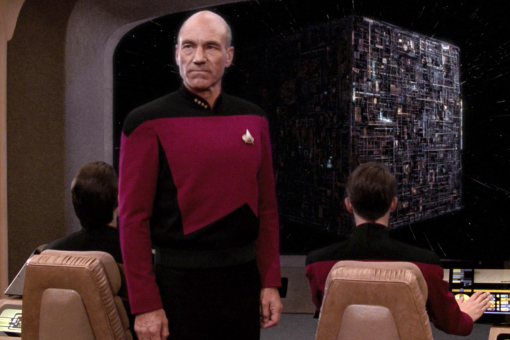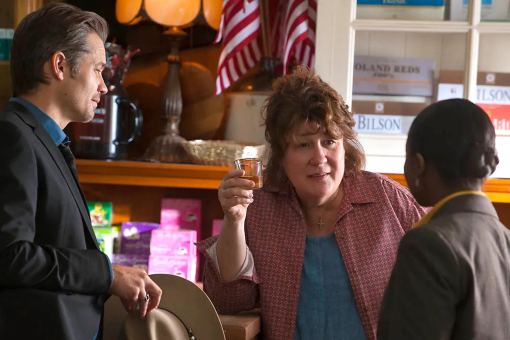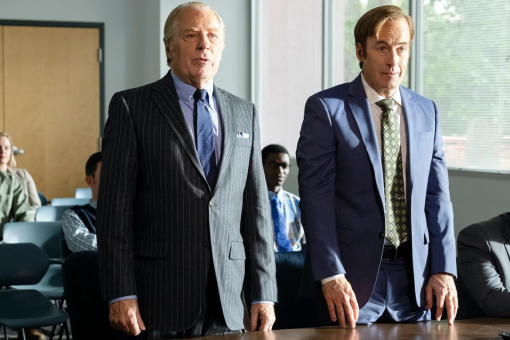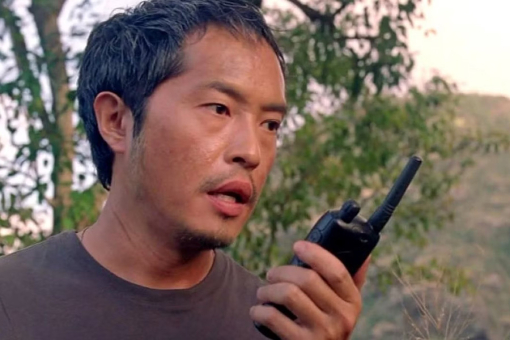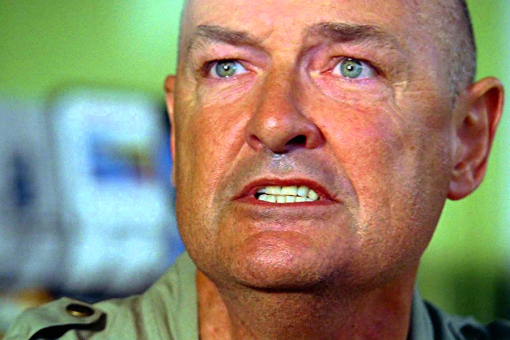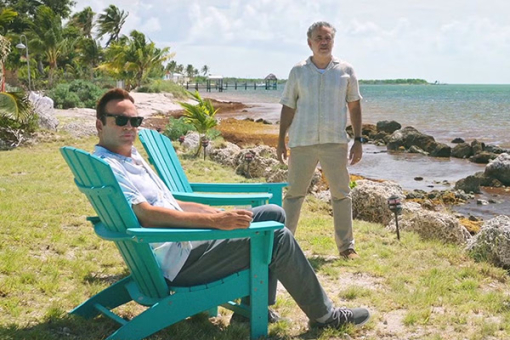It’s ironic (and somewhat fitting) that the last scene filmed for Star Trek: The Next Generation’s series finale involved the beginning of life on our planet.
TNG’s two-part finale, “All Good Things…,” centered on Captain Picard’s (Patrick Stewart) attempts — across three different time periods — to save the galaxy from a spacial anomaly made of anti-time. With a little help from Picard’s omnipotent nemesis, Q (John de Lancie), the past, present and future crews of the Enterprise-D struggled to restore temporal balance to the galaxy as Picard and Q paid a visit to primordial Earth. There, the anomaly — which gets larger the farther back in time we go — causes the building blocks of all life on Earth to never form, thus wiping out humanity before it ever had a chance to exist. The weight of this scene — and how the show’s pending conclusion would impact fans — was not lost on Stewart, who recently spoke to the Television Academy about his experience filming the finale. Shooting this pivotal sequence late at night — on TNG’s infamous “Planet Hell” set, which was often home to rock or cave-like planets — proved to be, well, we’ll let Captain Picard himself explain:
“We wrapped it at about 1:30, 2 in the morning, when everyone was absolutely beaten,” Stewart says. “Just the crew, exhausted, and the director [the late Winrich Kolbe] dragging John de Lancie and myself to the finish, practically. And that was the last scene we shot. We wrapped seven seasons of Next Generation with two actors, John and myself.”
While the series was done with Picard and his shipmates, Star Trek was not. Stewart, after having been in nearly every scene of the finale and having directed the series’ penultimate episode, “Preemptive Strike,” had less than two weeks off before he reported to film the first Trek movie featuring the Next Gen cast, 1994’s Star Trek: Generations. The transition from fans’ television screens to the silver screen was, occasionally, a bittersweet one for Stewart and his costars. “While we all realized that we would no longer be working together on a series, we did have the movies to look forward to,” Stewart explains.” “But it was still very emotional, ending the series.”
In honor of the recent 30th anniversary of “All Good Things…”, Stewart reveals what it was like shooting key sequences of the finale and how season seven came to be Next Gen’s last.
Television Academy: Prior to shooting “All Good Things…,” you had directed the previous episode, “Preemptive Strike,” and I can't imagine how stressful it must have been for you at that time. Can you recall how difficult it was for you to go from directing that episode to being in nearly every scene of the finale?
Patrick Stewart: Well, the difficulty was not getting enough sleep. [Laughs]
I bet.
Because you have to prep shows before you start shooting them. But while I was prepping one show, I was shooting another one as well as playing my own role. So it was a very intense and crazy time. It had never been planned that there would be seven seasons. And I think it was around season three when it was confirmed that there will be six seasons. And, of course, we were thrilled. It was a big compliment to the work that everyone had been doing — the writers, directors, crew, producers, studio. And I think when we were approaching, we were about halfway through season six that I was asked about doing a seventh season.
How did you react to that ask? What did you think?
Well, what I did was immediately go and talk to all of my fellow actors, because I had a marginally different status in the production, I think, as the leading character. But I only wanted to do what they wanted to do. So I talked to everybody: Jonathan [Frakes], Brent [Spiner], Michael [Dorn] LeVar [Burton], Gates [McFadden], Marina [Sirtis], as well as our directors and our producers. And everyone said, “Yes, let's give it a shot.” In fact, I think there were one or two of my beloved friends [on TNG] who would have liked to have gone on and done seasons eight, nine and 10. [Laughs] The series had already taken up seven years of my life — and five more were going to be taken up with the movies that we made, that we were going to shoot. So it had been an intense period of my life, a period of my life I had never expected to experience at all. Doing a television series that would run for year after year after year, that was not on my list of ambitions. And it, of course, had such an impact on my life. I had never experienced anything like it. And critical to that was my relationship with the rest of the cast, whom I met first in 1987. And every day that I don't see them now in 2024, I miss every one of them. And I don't think I've ever had so much fun as I have shooting Next Generation.
Did you have fun shooting the finale’s scenes where Picard was in old age makeup, sporting a beard for the first time on the show?
I loved it. Let me say, first of all, that we had a brilliant makeup team with Michael Westmore. The Westmore family. At one time, I believe every one of the major studios in Hollywood had a Westmore. I’ve always enjoyed the fun of sometimes appearing as a character whom the audience would know was Captain Picard, but he would appear in a funny or different costume or in makeup.
How did you celebrate when they finally wrapped on season seven?
I can't remember what I did exactly, but I do think I slept for several days.
I was going to say, I hope they gave you some time off between wrapping and starting Generations. I heard it was something like two weeks —
Oh, it was much shorter than that. [Laughs] They had already started shooting some of the movie when we were shooting the final episode. There were lots of scenes with Bill Shatner in them that we were not in. And so they were already working, and it meant that we could sneak in, because they were filming on the Paramount lot where we shot, well, not all of our episodes. Of course, about every four episodes or so, we would go on location somewhere — which was always a little bit like having a holiday. At least we treated it as a holiday.
I am guessing the cast was fairly emotional when shooting the famous poker table scene that ends “All Good Things…,” which you and the cast recreated for the finale of Star Trek: Picard. I know it’s been 30 years, but how was it for you filming what would become such an iconic moment for the franchise?
Well, it was intense. But we still had a few more days of work ahead of us. It was not the last scene of the series that was shot. The scene that John de Lancie and I had on [primordial Earth], that was the last scene we shot. We wrapped it at about 1:30, 2 in the morning, when everyone was absolutely beaten. And throughout the day, we'd had visitors. It's one of the reasons we were so far behind. We had so many visitors — important, distinguished visitors. And as we got into the evening shooting, of course, the visitors thinned out. And the later it got, there were no visitors at all. Just the crew, exhausted, and the director, Kolbe, dragging John de Lancie and myself to the finish, practically. And that was the last scene we shot. We wrapped seven seasons of Next Generation with two actors, John and myself. And for the poker scene, of course emotions ran high. I believe, just off the set somewhere, behind the wall there to where they were playing poker, crew members and executives were on set to observe [filming], and it’s safe to say there were few dry eyes in the house. While we all realized that we would no longer be working together on a series, we did have the movies to look forward to. And we were aware that this would also have an impact on the fans, for without them, we wouldn’t be here still talking about the work we achieved. But it was still very emotional, ending the series.
Speaking of the late Winrich Kolbe, the writers of “All Good Things…” and Frakes, they’ve all said that he was one of their favorite directors, and that they were very happy that he got the assignment for the finale. Can you recall what your relationship was like working with him?
It was wonderful. He was wonderful; a mixture of stern and serious instructions as well as lightheartedness. And we enjoyed him [on set] very much. But everything that I've just said would have applied to several more directors as well. And, of course, when Jonathan began directing, that was wonderful. And Gates, too. LeVar did several as well. Both he and Jonathan have both got great directing careers.
How would you rate your experience directing episodes of Next Gen?
I loved every moment of directing, because I never thought it was something I would do. I didn't have ambitions to do it. But when we saw what Jonathan was doing, and then I think when I saw what LeVar was doing, I went along and said, “Please, sir, can I have a go, too?”
The Western episode you directed, “A Fistful of Datas,” is a popular one among the fans.
I'll tell you a secret about that. We filmed the Wild West town village on the Warner Bros. lot. And they had an extraordinarily extensive outdoor set of a Western town. And so I was told, “Okay, we're going to shoot all the Western scenes, the exterior scenes at Warner Bros.” And I said, “Great, but there's an awful lot.” And they said, “Yes, there is. We're going to have to be very tight and work very hard to get everything in.” And we actually started filming the first shot in the dark. The sun hadn't come up. And I said, “Hang on a minute. It doesn't matter that there's no sunshine. We could film this in the dark, to help save us some time.”
And [the shot] was Brent, as his cowboy character, hiding around a corner. It just looked like a dark, shadowy corner, which was helpful for our intentions. And then we raced through the day. I mean, we just didn't have the time to spend, because if we didn't shoot it, it wasn't going to get shot. But we did. And that was very challenging to a new director shooting his first Western.
This interview has been edited for length and clarity.
All seven seasons of Star Trek: The Next Generation are streaming now on Paramount+.







